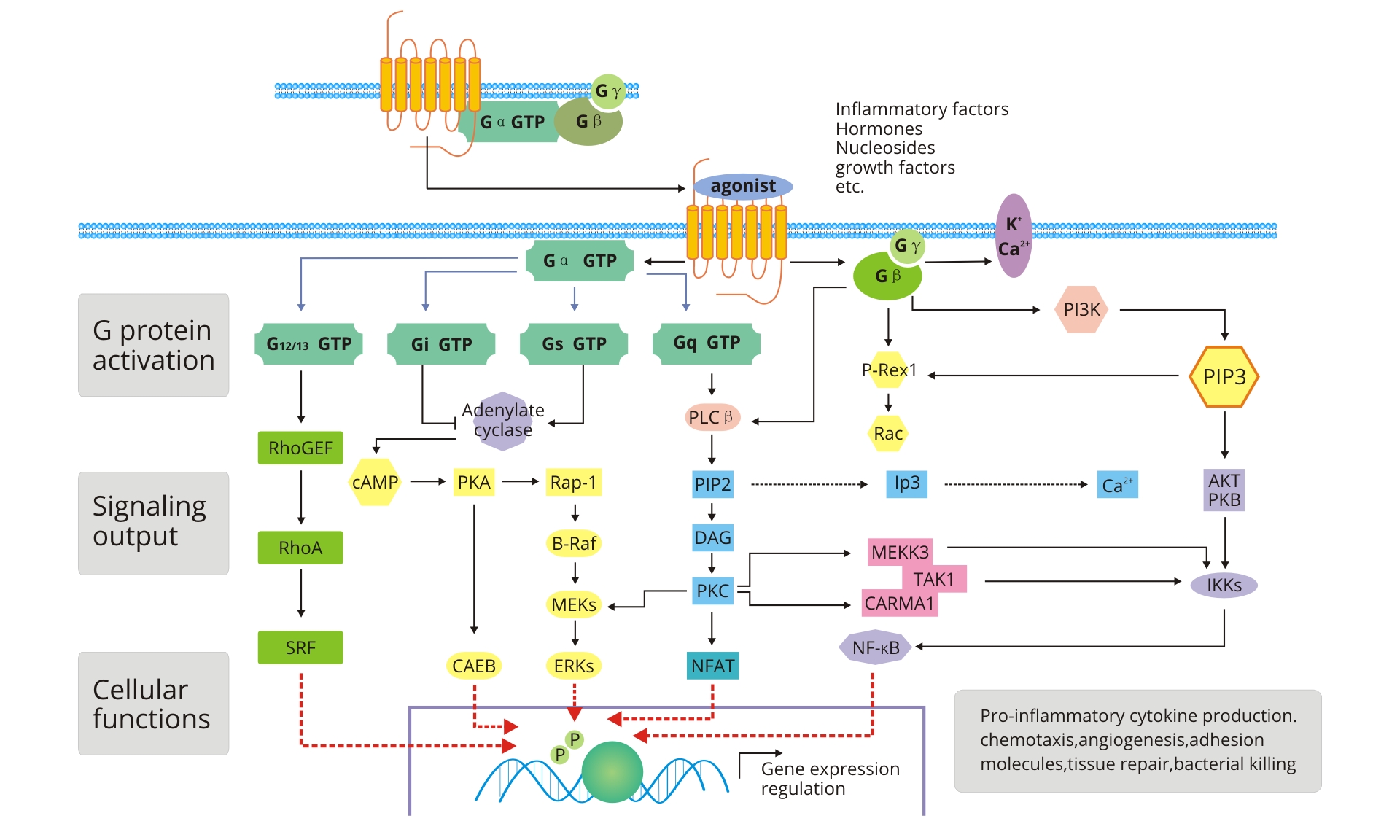
What Are G protein-coupled receptors?
As the name implies, G protein-coupled receptors (GPCRs) are coupled to intracellular heterotrimeric GTP-binding regulatory proteins (G proteins) when perceiving various extracellular signals. These signaling molecules include biological amine hormones like adrenaline, norepinephrine, histamine, and 5- hydroxytryptamine, and peptide hormones such as bradykinin, luteinizing hormone, and parathyroid hormone, as well as odor molecules and light quanta. GPCRs contain 7 membrane-spanning helices connected by three short extracellular (ECL) and intracellular (ICL) loops, so they are also known as 7-transmembrane receptors (7-TM receptors).
What Is the GPCR signaling Pathway?
GPCR can be activated by various ligands, including inflammatory factors, hormones, and growth factors. Active GPCR exhibits the characteristics of guanylate exchange factor (GEF). Following being coupled to the G protein, active GPCR facilitates the rapid GDP→GTP nucleotide exchange, which activates the G protein, promoting disassociation of the Gα subunit from the Gβγ dimer, allowing each to modulate the activity of specific effector proteins. This process ultimately triggers cascade amplification of multiple signals, which completes the transfer of extracellular signals across the membrane into the cell thus resulting in various biological effects, including cell proliferation, survival, differentiation, migration, extracellular matrix degradation, angiogenesis, metastasis, and cancer tumorigenesis, etc.
Gα subunits are divided into four subfamilies: Gαs, Gαi, Gαq/11, and Gα12/13, each of which induce different downstream effectors thus triggering distinct cellular responses.
Gαs increases adenylate cyclase (AC) activity, catalyzes the synthesis of cGMP from ATP. cAMP further results in the activation of PKA, eliciting the Rap-1→B-Raf→MEKs→ERKs or PKA→CAEB cascade events, finally regulating gene transcription.
Gαi is an inhibitor of AC and leads to a decrease in cAMP levels, suppressing the cAMP-dependent pathway.
Gαq/11 activates phospholipase C beta (PLC-β) anchored on the plasma membrane. PLC-β catalyzes the hydrolysis of PIP2, which is the inner lipid of the cell membrane, producing DAG and IP3.
IP3 diffuses to the surface of the endoplasmic reticulum (ER), combines with the IP3-gated calcium ion channel, opening the calcium ion channel, and allowing calcium ions from the endoplasmic reticulum cavity to flow out, thus resulting in a sharp increase in the calcium ion concentration of the cytoplasmic matrix. Calcium ions combine with free PKC in the cytoplasmic matrix, guiding it to transport to the cytoplasmic surface of the cell membrane and combining with the DAG on the endoplasmic layer of the cell membrane to completely activate PKC. PKC catalyzes the phosphorylation of downstream transduction proteins to produce different responses, such as cell secretion, muscle contraction, cell proliferation, and differentiation.
The Gα12/13 can modulate the small G-protein RhoA via effectors DH and PH domain cassettes characteristic of RhoGEFs. Activated Gα12 and Gα13 subunits can evoke PDZ-RhoGEF activity. Gα13 directly interacts with p115RhoGEF and increases related RhoGEF proteins linked to the Rho activation.
Gβγ subunits participate in regulating K+, Ca2+ channels activity. In addition, Gβγ subunits can serve to recruit proteins to the plasma membrane, including PI3K, P-Rex-1, and β-adrenergic receptor kinase. Many effectors are regulated both by α and βγ subunits.
The Function of the GPCR signaling Pathway
GPCR signaling pathways are involved in many physiological processes, including the mediation of photosensitivity and olfactory, behavioral and emotional regulation, immune system modulation, autonomic nervous system regulation, cell density regulation, homeostasis maintenance, and so on.
The GPCR signaling Pathway and Diseases
GPCRs almost regulate almost all known physiological processes and have a prominent position in the clinic. Therefore, defects in the GPCR signaling pathway will bring about various dysfunctions and diseases.
GPCR-mediated signal transduction pathway abnormalities can be seen in cardiovascular diseases, genetic diseases, tumors, and some infectious diseases.
Cholera toxin catalyzes the loss of GTPase of the alpha subunit of the G protein, leading to continuous activation of AC. AC decomposes ATP to produce a large amount of cAMP, which opens the ion channels on the cell membrane, causing a large number of ions and water flow from the cell membrane to the outside of the cell thus resulting in dehydration symptoms.
Mutations in GPCR receptors can lead to various acquired and inherited diseases, such as retinitis pigmentosa (RP), hyperthyroidism, renal diabetes insipidus, some fertility disorders, and even cancer. Mounting evidence has revealed that there is a correlation between GPCR signal abnormalities and the occurrence and development of cancer. Many GPCRs are highly expressed in specific cancer cells. For example, LPA receptors are highly expressed in ovarian cancer, breast cancer, colon cancer, and prostate cancer, and endothelin receptors are highly expressed in colon cancer, prostate cancer, and melanoma.



